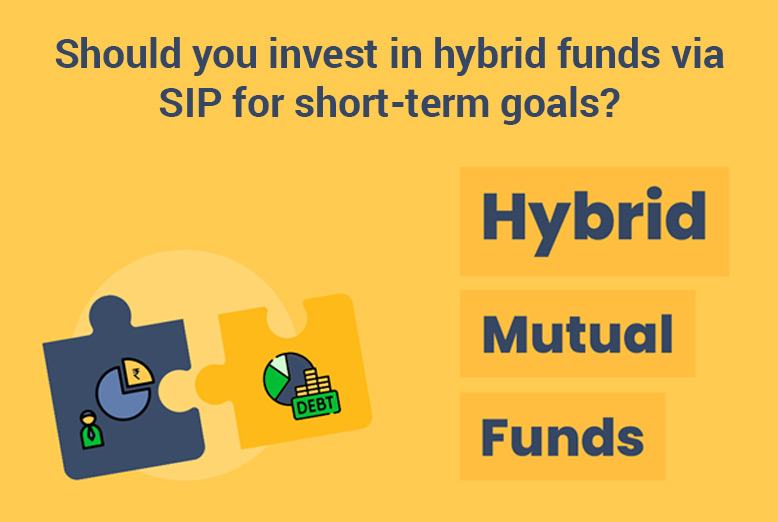You often start your financial journey with a few goals in mind. Once your financial goals are in place, you may find a few suitable ways to work towards them. Some goals may be short-term, while some may be long-term. For short-term objectives like planning for a vacation or purchasing a vehicle, you may look at combining the discipline of a Systematic Investment Plan (SIP) with the flexibility of hybrid funds. But you may wonder if the same strategy is viable in the long term.
Let’s explore this concept further to understand this better.
Understanding SIP and how it works
A Systematic Investment Plan allows you to put in a fixed amount of money at regular intervals, mostly monthly, in a mutual fund scheme of your choice. This structured approach not only helps you build financial discipline but also helps spread your investment across market cycles. With a Systematic Investment Plan, you don’t need to time the market. SIPs may allow investors to potentially benefit from rupee cost averaging and the power of compounding.
For short-term goals, a Systematic Investment Plan may provide a way to build a regular investment pattern, even if the horizon is two to five years. However, the fund selection here comes into play.
What are hybrid funds?
Hybrid funds are a type of mutual fund scheme that invest in a mix of equity, debt and other asset classes. The equity portion may potentially provide growth, while the debt allocation may potentially balance the portfolio. The proportion between these asset classes depends on the type of mutual fund you choose. Some hybrid funds have a higher focus on equity, while others may focus on debt.
When linked with a Systematic Investment Plan, hybrid funds can allow investors to build exposure across different asset classes. For someone with a short-term horizon, the debt allocation in hybrid funds might provide cushioning against market fluctuations, though returns are not guaranteed.
Are hybrid funds via SIP suitable for short-term goals?
Whether a Systematic Investment Plan in hybrid funds is suitable for short-term goals depends on a few considerations:
- Time horizon: If the goal is within two to three years, market volatility in the equity portion of a hybrid fund may still affect returns. Shorter horizons generally benefit from a more stable allocation.
- Risk tolerance: Even hybrid funds carry market-linked risks. If an investor is sensitive to fluctuations, the equity portion could cause discomfort.
- Nature of the goal: For non-negotiable goals such as paying for education fees due in three years, even small fluctuations may matter. For flexible goals like travel, investors may be comfortable with some variation in outcomes.
Thus, while a hybrid fund through SIP may be considered for certain short-term goals, the suitability depends on the balance between risk tolerance and goal flexibility.
Planning steps before starting a SIP in hybrid funds
Before starting a Systematic Investment Plan, investors may consider a few steps:
- Define the goal clearly – For example, is it a three-year vacation fund or a five-year car purchase corpus?
- Assess the timeline – The shorter the timeline, the greater the impact of volatility.
- Estimate the required corpus – Account for inflation in estimating how much the goal may cost.
- Evaluate affordability – Check whether the suggested SIP contribution fits comfortably within your monthly budget.
- Review alternatives – Compare hybrid funds with other available options to see what may be more suitable for the specific goal.
Factors that can affect short-term SIP outcomes
Several factors can influence how effective a Systematic Investment Plan in hybrid funds may be for short-term goals:
- Market conditions – Equity allocations may fluctuate significantly even over short horizons.
- Debt market movement – Interest rate changes can influence the debt portion of hybrid funds.
- Contribution amount – Underestimating the required SIP amount may lead to underfunding of the goal.
- Review frequency – Revisiting the SIP regularly helps align it with changes in income, expenses, or timelines.
Using calculators to estimate contributions
To know how much to invest monthly, investors can use online SIP calculators. These tools provide an estimate based on inputs such as target amount, time horizon, and assumed rate of return. While results are only indicative, they may help investors plan more systematically. The calculator is an aid, not a prediction tool. It may provide only an indicative picture.
Hybrid mutual funds in India and short-term suitability
When evaluating short-term investing, it is important to remember that hybrid mutual funds in India can vary widely in their equity-debt mix. Some may be more equity-oriented, which increases potential return but also volatility. Others are debt-oriented and may be relatively more stable but with lower return expectations. For short-term goals, investors may lean toward relatively conservative hybrid options, though they remain subject to market risks.
Conclusion
A Systematic Investment Plan is a structured way to invest for both short-term and long-term goals. When linked with hybrid funds, it can provide diversified exposure to equity and debt. For short-term goals, however, suitability depends on the time horizon, the nature of the goal, and the investor’s comfort with market-linked fluctuations. While calculators can offer useful estimates, actual outcomes may differ. Reviewing the SIP regularly and aligning it with financial objectives can help investors remain on track.Mutual Fund investments are subject to market risks, read all scheme related documents carefully.
This document should not be treated as an endorsement of the views/opinions or as investment advice. This document is for information purposes only and should not be construed as a promise of minimum returns or a safeguard of capital. This document alone is not sufficient and should not be used for the development or implementation of an investment strategy. The recipient should note and understand that the information provided above may not contain all the material aspects relevant for making an investment decision. Investors are advised to consult their own investment advisor before making any investment decision in light of their risk appetite, investment goals and horizon. This information is subject to change without any prior notice.
Also read: How to Use an SIP Step-Up Calculator to Maximise Your Investment in India







